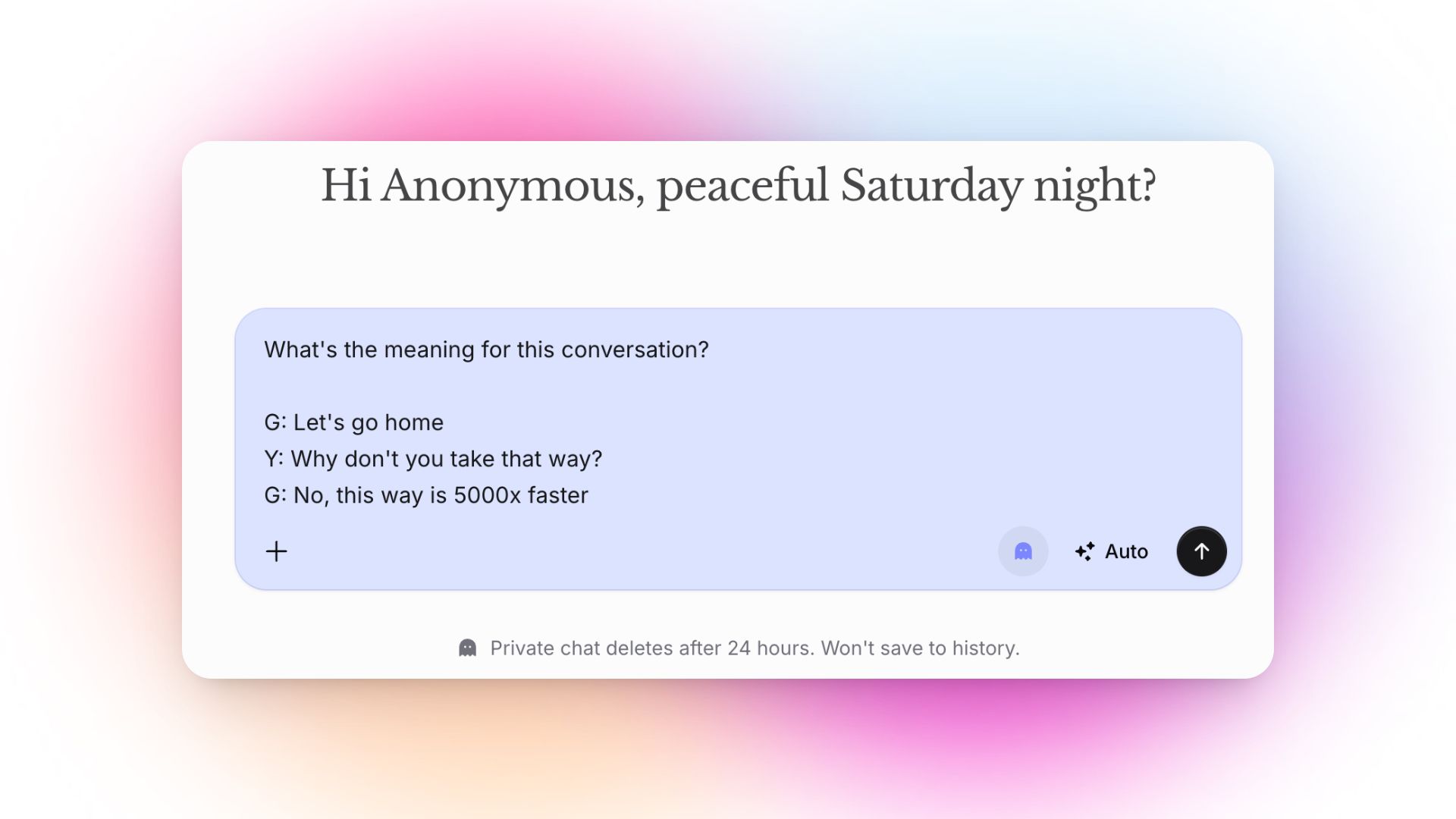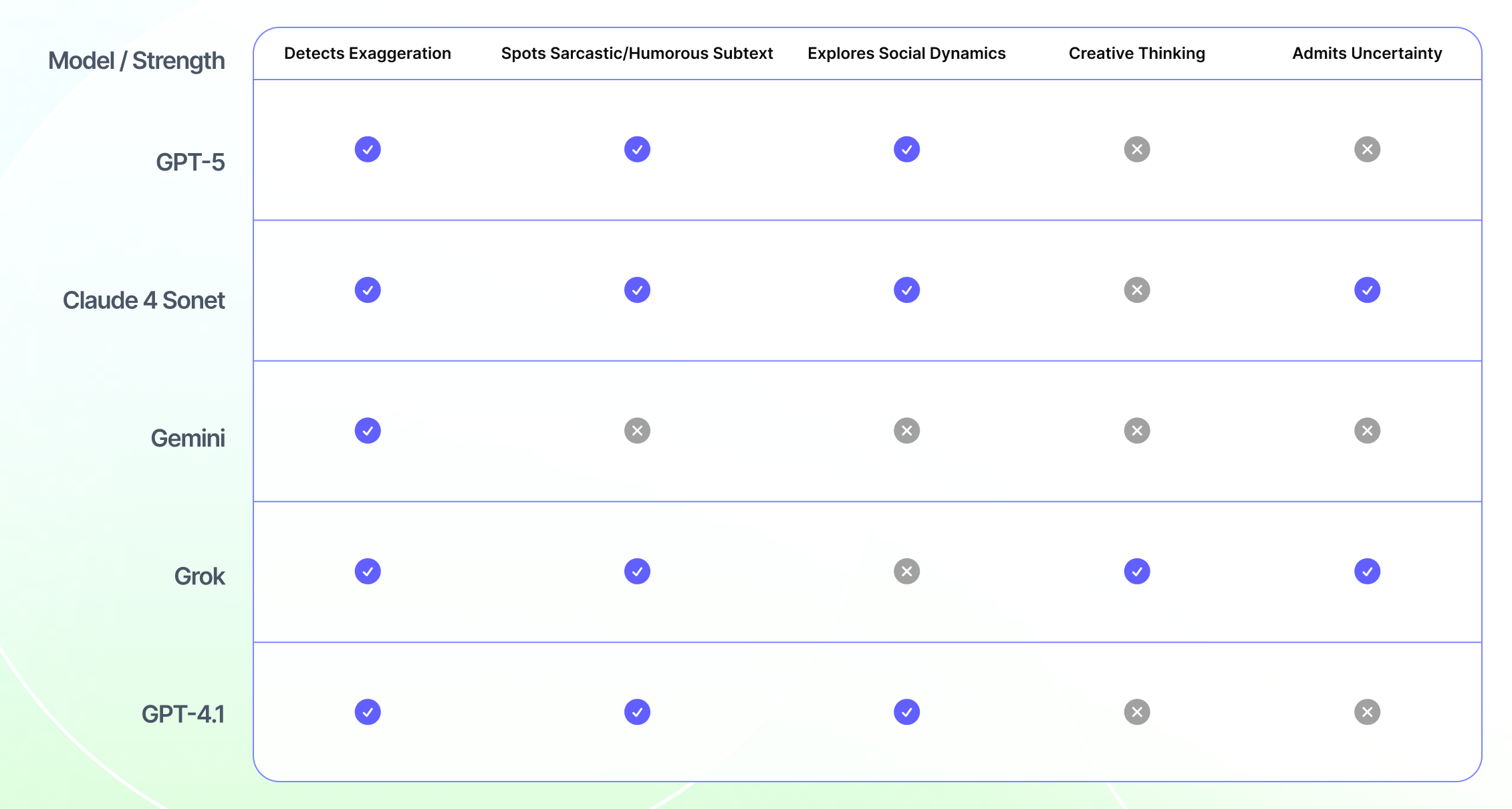Introduction
Understanding sarcasm is one of the trickiest aspects of human communication, even for humans. For AI models, the challenge is even greater, requiring not just literal language processing, but also interpretation of intent, context, subtext, and social cues.
To explore how advanced models handle sarcasm and hyperbole, we analyzed how five leading LLMs (GPT-5, Claude 4 Sonet, Gemini 2.5 Flash, Grok, and GPT-4.1) interpreted a simple but ambiguous conversation:
The conversation
G: "Let's go home."
Y: "Why don't you take that way?"
G: "No, this way is 5000x faster."

A privacy-focused chat interface from Invent, invites the user with a friendly greeting and shows a sample analysis task, while indicating that all messages will be deleted after 24 hours to ensure user privacy.
How the models analyzed the sarcasm
1. GPT-5
Key Points:
- Identifies exaggeration (“5000x faster”) as hyperbole.
- Understands “5000x” isn’t literal, just means “way faster.”
- Picks up on possible playful or sarcastic tone.
- Provides a “natural rephrasing” and paraphrase showing understanding of social context.
Strength: Nuanced handling of subtext and humor.
2. Claude 4 Sonet
Key Points:
- Recognizes “5000x faster” as dramatic exaggeration.
- Digs into personality (“confident, emphatic, impatient”) and conversational styles.
- Explains how hyperbole and relationship dynamics are at play.
- Suggests possible scenarios and explores underlying messages.
Strength: Excellent at mapping literal and social dimensions; considers decision-making dynamics.
3. Gemini 2.5 Flash
Key Points:
- Provides clear, literal breakdown of each line.
- Registers “5000x faster” as likely exaggeration, focused on efficiency.
- Less emphasis on possible sarcasm/humor, more surface-level reading.
Strength: Accurate, succinct, but less interpretive or nuanced.
4. Grok 4
Key Points:
- Sees possible tech-world wordplay (“G” as Google, “Y” as Yahoo).
- Interprets “this way is 5000x faster” as a jab at Google’s speed vs. Yahoo.
- Offers alternative readings and meta-analysis (including potential puns and riddles).
- Checks for hallucination and admits when uncertain—a rare transparency.
Strength: Creative, lateral thinker; not afraid to make unconventional connections or admit uncertainty.
5. GPT-4.1
Key Points:
- Breaks down literal and implied meanings.
- Identifies “5000x faster” as hyperbolic humor.
- Recognizes friendly disagreement and characterizes G as prioritizing efficiency.
- Provides a summary table for clarity.
Strength: Systematic analysis, giving both structure and nuance.
What does this show about AI and sarcasm?
Most top models can recognize basic hyperbole (“5000x faster” isn’t literal).
Interpreting subtle sarcasm, playful jabs, or social power dynamics varies, more advanced models like GPT-5, Claude 4, and GPT-4.1 dig deeper.
Creative, lateral interpretations (like Grok’s tech pun) add value, even if sometimes they stretch the context!
Some, like Gemini 2.5, focus on the literal and don’t always venture into subtext.
Admitting uncertainty and offering multiple alternatives is a sign of “humble AI” (Grok stands out here).
In other words, Grok is the "winner" for creative, inspired guesses and self-awareness. But if your criteria is reliable sarcasm and social nuance detection, GPT-5, Claude 4, and GPT-4.1 edge ahead for accuracy and practicality.

This table compares the nuanced conversational abilities of major AI models (Grok, Claude 4, Gemini and GPT-5 and 4.1), highlighting which can recognize exaggeration, spot sarcasm, explore social contexts, think creatively, and admit uncertainty.
Takeaways & real-world impact
For developers: Understanding where models succeed or fail with sarcasm is crucial, it affects everything from chatbots to sentiment analysis.
For users: Even the best AI occasionally misses the mark or overthinks, a reminder that human oversight is always needed.
For researchers: These nuanced differences show that truly "getting" sarcasm requires much more than language skills, social awareness, context, even world knowledge.
In real life
Imagine two friends arguing about the fastest way home. One dramatically claims “this way is 5000x faster!” Most humans instantly spot the exaggeration, and maybe the sarcasm. Advanced AI is getting better at tagging this, but as we see, some models still miss nuances or invent wild theories.
Final thoughts
AI is learning to laugh with us, but it’s not quite ready to win at irony, sarcasm, or the family dinner debate. Yet, the rapid improvement is clear, and watching how different models “think” offers a fascinating peek into the future of machine understanding.
How well do you think AI can really “get” humor?
Try your favorite models on the same exchange and see what they come up with.

